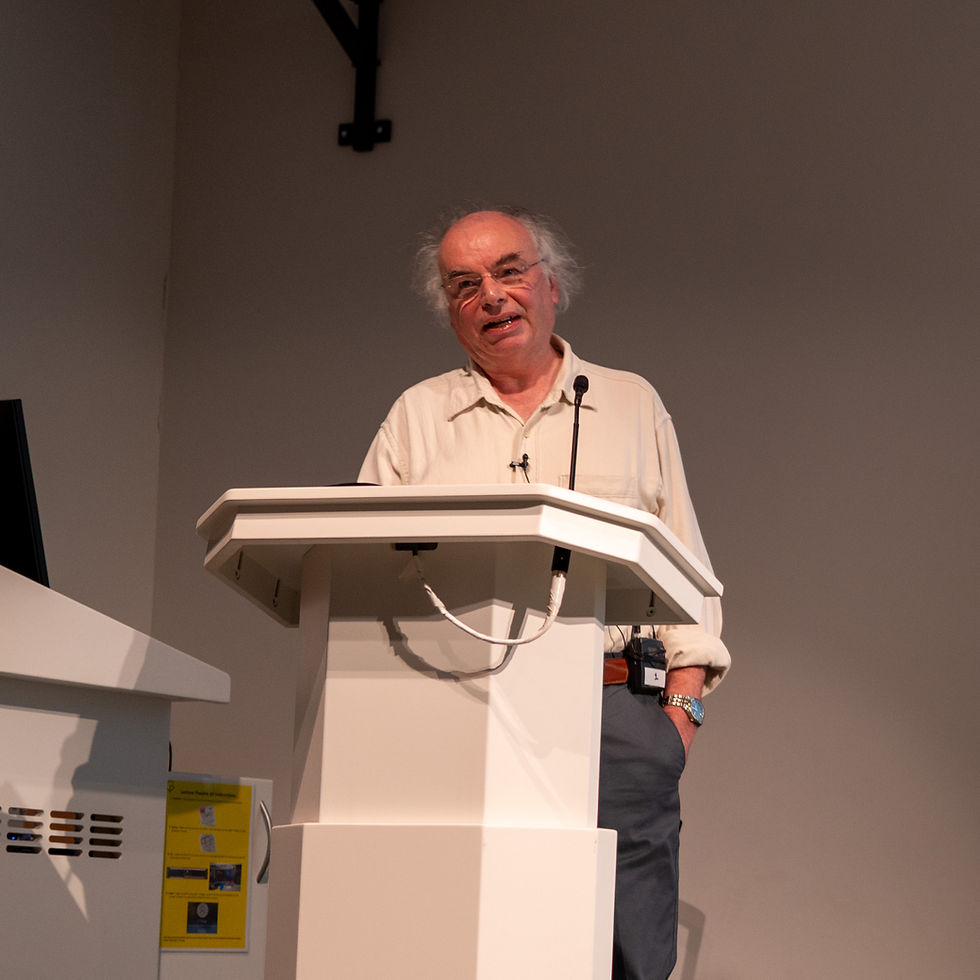Are We Alone? by Dr Robin Catchpole
- Paul May

- Dec 11, 2023
- 3 min read
Asterisms and Christmas Trees
Before the main lecture Mike Meynell entertained us with the celestial highlights for the festive period. Top of this list are the Geminids - an annual meteor shower which now completes very favourably with the August Perseids. I learnt a new word, 'asterism', which refers to a pattern of stars without a constellation name. The Winter Circle/Hexagon, easily constructed from some of the brightest stars in the winter skies, contains many deep sky objects of interest as well as a large section of our own Milky Way. For our night viewing homework, in addition to meteor spotting (peaking on 14/15th December with the radiant centered at Castor), we have the very seasonal and relatively close Christmas Tree cluster and the spectacular Double Cluster in Perseus.
Honorary life members
Our host and chairman, Bobby Manoo, then announced two very deserving lifetime membership awards. First to Helen Edwards our previous vice-chair who has worked tirelessly for many years for the society particularly in organizing our main lectures. And next, to Martin Male who has been involved from the society's early days and has hosted very popular dark sky observing from his 'garden shed' observatory in Romney! Both also received signed copies of the latest Astrophotographer of the Year book.
Are We Alone? The case for the defence.
For the main lecture, Robin entertained us with a well-structured argument for our uniqueness in the universe. This is certainly not to say that life, defined as 'a self-sustaining chemical system capable of Darwinian evolution' is restricted to our planet. Indeed given the tenacity of life on earth and its ability to live in a variety of very hostile environments, we may even find it or evidence for its previous existence in other parts of our solar system. We have begun searching on Mars, but there are good reasons to also include the Jovian moons Europa and Gannymede and the Saturnian moons Titan and Enceladus.

Goldilock habitats may be rare
With our newfound ability to detect exoplanets outside our solar system, we are able to judge how common earth-type planets are in the galaxy. Though gas giants in particular seem very common, the identified existence of planets with the right mass and size and distance from their sun to support complex life is rare indeed. Furthermore our unusually large moon (given Earth's size) helps stabilize changes in Earth's tilt and therefore provide a more stable temperature environment for our planet. We also have the protection from asteroids afforded by the gravitational attraction of Jupiter which has an unusually large orbit for a gas giant.
Life - off to a quick start
Around 4 billion years ago the first unicellular organisms (prokaryotes) sprung to life. This is barely 1 billion years after the planets formation, a period that had in any case been dominated by heavy asteroid bombardments which would make any life inconceivable. We had to wait, however, a further 2 billion years for structured cells (eukaryotes) and another billion years for multicellular organisms suggesting these were very difficult evolutionary steps. The subsequent explosion of life forms was encouraged by the accelerated evolutionary pressures on small populations that remained after a number of 'catastrophic' mass extinctions. Fast forward 600 million years to the first hominids and a further 5 million years to homo sapiens. Given the large number of unlikely steps required to get to where we are today, perhaps we need to reconsider the prevailing view that other intelligent and communicating species must exist in our galaxy and the wider universe.

The Drake Equation and the Sound of Silence
This famous equation provides a useful starting point for calculating the probability of other sophisticated species on other planets. Though we have started looking closely for communications from other worlds, we are currently met with a deafening silence. Why? Perhaps the key ingredient that dictates this silence is the robustness of advanced civilizations. If we regard 50000 years as a self limiting average period for advanced civilizations to survive, then the Drake equation with other reasonable assumptions leads to the conclusion that we may indeed be currently unique in our galaxy. Hence the silence.

We the jury decide!
Robin was careful to distinguish science-based factual information from necessary assumptions, and to emphasize that his conclusion was therefore very much a personal opinion. We all need to make our own conclusions. Perhaps we are not alone and we haven't been listening carefully enough. And appropriately he therefore finished off with a quote from John Haldane: '... the universe is not only stranger than we suppose, but stranger than we can suppose'.

Thank you Robin for a most entertaining, polished and thought-provoking talk.




































Comments